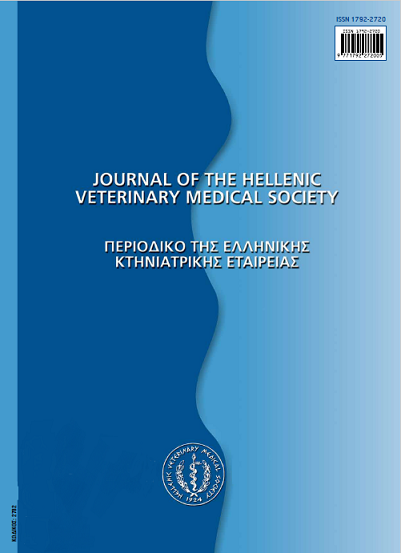Eosinophilic dermatitis with edema (Wells'-like syndrome) possibly triggered by cooked fish in a dog
Аннотация
A 2-year old intact female mongrel dog was admitted with multifocal skin lesions appearing suddenly and extending symmetrically over most of the body. The dog was living indoors and one day before the admission it had consumed cooked fish. Neither medication, nor vaccination had been given to the dog, at least during the last 3 months. Physical examination revealed only non-pruritic and non-painful macules, papules and plaques that were distributed mainly over the head, pinnae, neck and thorax. The lesions were annular, aeriform or serpiginous with a tendency to coalesce. Skin histopathology (H-E) revealed a superficial dermal edema, post-capillary venule congestion and perivascular to interstitial eosinophilic dermatitis as the main pattern. The dog was initially placed on oral vitamin E, sulphasalazine and doxycycline, but to no avail. As soon as the diagnosis of eosinophilic dermatitis with edema was confirmed by histopathology, the former treatment stopped and oral prednisolone was given for two months during which there was a remarkable improvement of skin lesions and complete disappearance with no relapse. The cooked fish, consumed by the dog the night before the incident, was assumed to be the cause of the acute eosinophilic hypersensitivity reaction.
Article Details
- Как цитировать
-
GIANNOULOPOULOS (Γ.Δ. ΓΙΑΝΝΟΥΛΟΠΟΥΛΟΣ) G. D., FARMAKI (Ρ. ΦΑΡΜΑΚΗ) R., KOUTINAS (Χ.Κ. ΚΟΥΤΙΝΑΣ) C. K., & KOUTINAS (Α.Φ. ΚΟΥΤΙΝΑΣ) A. F. (2017). Eosinophilic dermatitis with edema (Wells’-like syndrome) possibly triggered by cooked fish in a dog. Journal of the Hellenic Veterinary Medical Society, 62(4), 320–326. https://doi.org/10.12681/jhvms.14862
- Выпуск
- Том 62 № 4 (2011)
- Раздел
- Case Report
Authors who publish with this journal agree to the following terms:
· Authors retain copyright and grant the journal right of first publication with the work simultaneously licensed under a Creative Commons Attribution Non-Commercial License that allows others to share the work with an acknowledgement of the work's authorship and initial publication in this journal.
· Authors are able to enter into separate, additional contractual arrangements for the non-exclusive distribution of the journal's published version of the work (e.g. post it to an institutional repository or publish it in a book), with an acknowledgement of its initial publication in this journal.
· Authors are permitted and encouraged to post their work online (preferably in institutional repositories or on their website) prior to and during the submission process, as it can lead to productive exchanges, as well as earlier and greater citation of published work.











